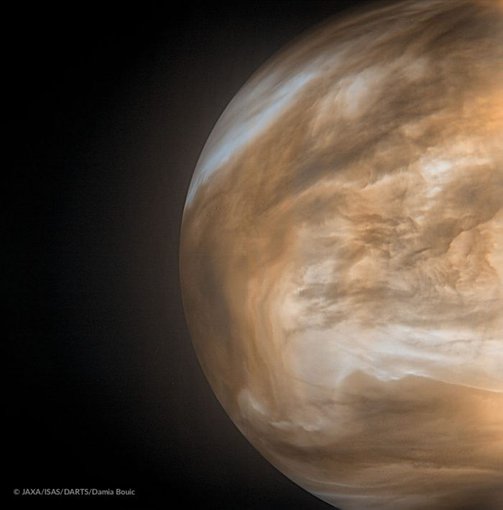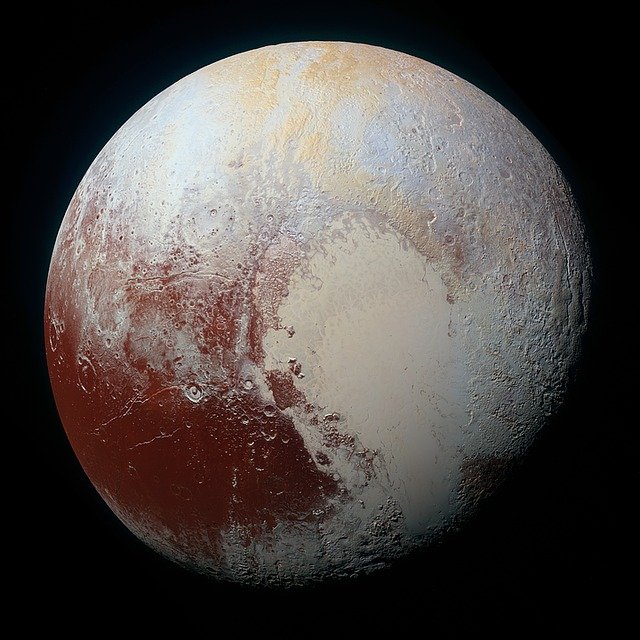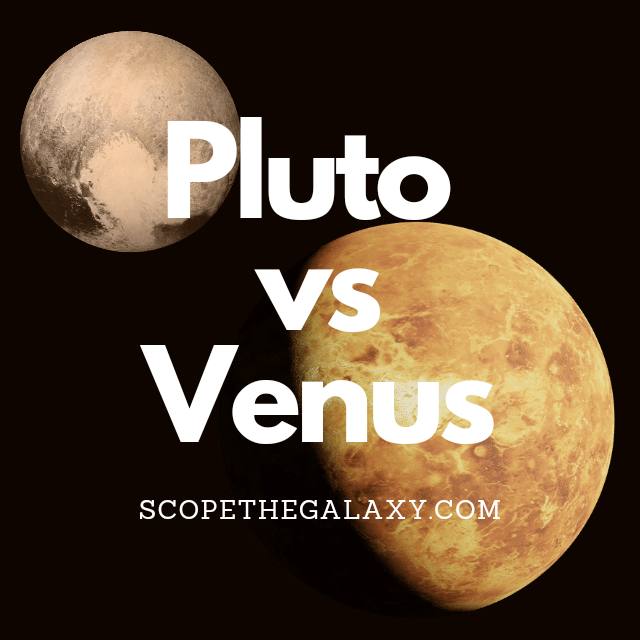*This post may contain affiliate links. This means we may make a commission if you purchase an item using one of our links*
The main differences between Venus and Pluto is that Venus is the hottest and brightest planet in our solar system, Pluto has 5 moons whilst Venus has 0, Pluto is a dwarf planet whilst Venus is a normal planet, It takes Pluto 157 hours to complete a day whilst Venus does so in 243 days and Venus is the 2nd closest planet to the Sun whilst Pluto is the farthest planet from it.
These are some of the more prominent differences but, there are a number of other unique features that separate too. Continue reading if you want a more detailed look at both Venus and Pluto along with differentiates the two.
What Is The Planet Venus?
Table of Contents

Venus is the 2nd closest planet to the Sun and is often regarded as Earth’s sister planet. It’s very close to our Earth in size where its diameter is 12,104km. This is just over 600km less wide than our home planet.
Unlike all the planets further outside the Sun’s orbit, Venus and even mercury have no moons orbiting it. The most probable reason for this is due to its closer proximity to it, which means that smaller objects orbit the Sun as opposed to Venus.
Venus is also the hottest planet in our solar system where its surface temperature is 475 degrees Celsius. This is due to a number of factors, like the thicker atmosphere, close proximity to Sun, the reasons for which have been explained in more detail here.
It’s core is hot too, similar to that of the ice giants and Earth, where it stands at 5,200 degrees Celsius.
As a result of this thicker atmosphere, Venus is also able to reflect a lot more of the light the Sun projects at it, making it both the hottest and brightness planet in our solar system. This is why for the longest time, and even till this day Venus is often referred to as the morning or evening star.
The thicker atmosphere is mostly compromised of carbon dioxide, and thick clouds of sulfuric acid. This does result sulfuric acid rain on the planets surface, which of course is very corrosive.
Being so close to the Sun also mean its orbital cycle is much shorter. It takes Venus 225 days to complete a full cycle, on the contrary a single day is actually longer than this where it takes around 243 days for a full rotation around its axis.
This is partially down to its distance from the Sun and the thick atmosphere surrounding this terrestrial planet. The axial tilt on Venus is also different from the other planets in our solar system where it is practically straight at 3 degrees.
All in all this is certainly one of the most interesting planets in our solar system and in many peoples eyes, could very well have supported life in the past based on how close its shape and size is to that of Earth.
What Is The Planet Pluto?

In the past Pluto was the 9th farthest official planet in our solar system however, in 2006 after many debates between astronomers, the International Astronomical Union officially downgraded it to a dwarf planet.
The reason for this downgrade at the time was primarily down to Pluto simply being too small when compared to every other planet and even the moons orbiting these planets. Pluto’s dwarf status is still debated to this day but, for now it remains under this dwarf bracket for a planet
Its diameter for example is only 2,370km, which is a third of Earth’s Moon. With that being said, despite the significant size discrepancy Pluto shows, it still does have more moon like objects orbiting it than Earth and I’m not saying just one more.
In total this terrestrial dwarf planet has 5.
Pluto’s atmosphere consists mostly of molecular nitrogen whilst molecules of methane and carbon monoxide have been observed also. As for its surface, it consist mostly of frozen nitrogen, methane, and carbon monoxide ices.
One of Pluto’s most unique characteristic is that Charon (its largest moon) is tidally locked to it and vice versa, which means that the two essentially orbit each other where, in essence only one side of Charon and one side of Pluto’s surface will face each other at any given time.
Pluto’s temperature is between -222 to -232 degrees Celsius based on how close it gets to the Sun when orbiting it, whilst its core temperature isn’t anything too special sitting around 500 – 1,000 degrees Celsius.
The main reason it’s as cold as it is and has a relatively cold core in comparison to the other planets would be mostly down to its size. A larger size would mean more mass could be compressed at the center which would produce more heat at the core.
Pluto’s orbit is also different from the other main plants in our solar system, following an elliptical orbital path as opposed to the circular path the others take. As a result of its distance from the Sun, Pluto will complete each one of these elliptical cycles around the Sun once every 247.78 years.
Even its rotational cycle is very slow, where one cycle is completed in 157 hours. Another interesting fact is the Pluto’s axial tilt is almost on its side at 57 degrees, similar to Uranus.
Similarities Between Venus And Pluto
Pluto and Venus do share a few similarities. They include the following:
- Both have a hotter central core.
- Both are a spherical in shape.
- Both are terrestrial planets.
- Both have an atmosphere and a rocky surface.
Differences Between Venus And Pluto
As for the differences between Venus and Pluto, they include the following:
- Pluto has 5 moons whilst Venus has 0.
- Venus is the hottest planet in our solar system with a temperature of 475 degrees Celsius in comparison to Pluto’s -222 to -232 degrees Celsius.
- Pluto’s core is colder too around 500 – 1,000 degrees Celsius whilst Venus is 5,200 degrees Celsius.
- Venus is the brightest planet in our solar system.
- Pluto is tidally locked to one of its moons whilst Venus is not tidally locked to any of its moons.
- It takes Venus 225 days to complete an orbit around the Sun whilst Pluto completes a cycle in 247.78 years.
- Pluto completes an orbit around its axis in 157 hours whilst Venus takes 243 days to complete a single orbit.
- Venus is the 2nd farthest planet from the Sun whilst Pluto is 9th.
- Venus is much bigger than Pluto with a diameter of 12,104km whereas Pluto’s diameter is 2,370km.
- Venus has a stronger magnetic field than Pluto.
- Pluto’s surface is made of frozen nitrogen, methane, and carbon monoxide ices whilst Venus’ surface is made of a plain full of volcanoes.
- Pluto’s axial tilt is 57 degrees whilst Venus has an axial tilt at 3 degrees.
- Pluto has an elliptical orbit around the Sun whilst Venus’ orbit is circular.
- Venus is heavier than Pluto with a mass of 4.867 × 10^24 kg whilst Pluto’s mass is 1.30900 × 1022 kg.
Summary
Although both Pluto and Venus are terrestrial planets, they still have very many things different from one another, whether it be their temperatures, size, brightness and even the number of moons that orbit them.
That’s why despite being spherical planets that orbit our Sun, the function very differently from one another and have a huge number of distinct features as has been discussed above.

